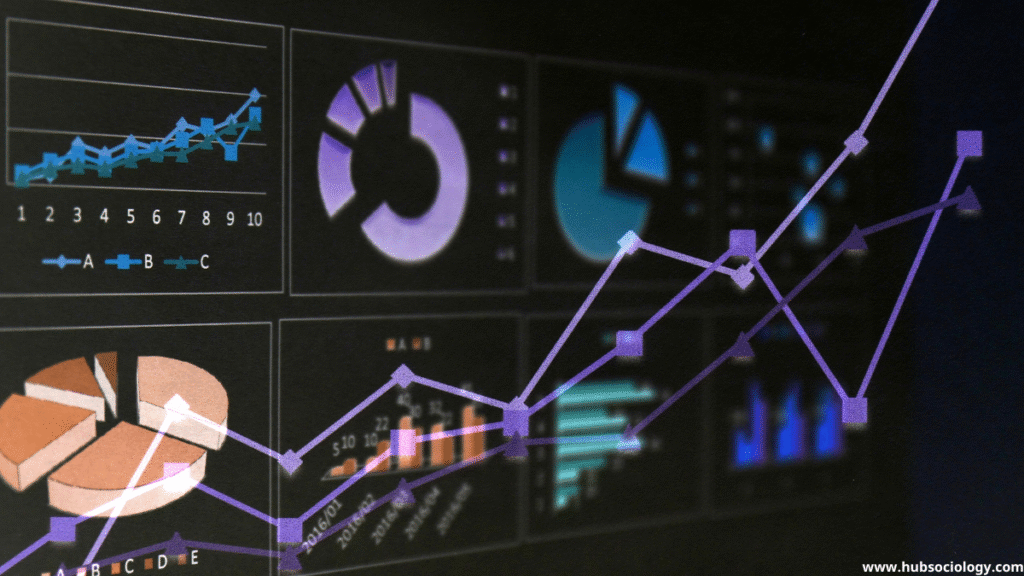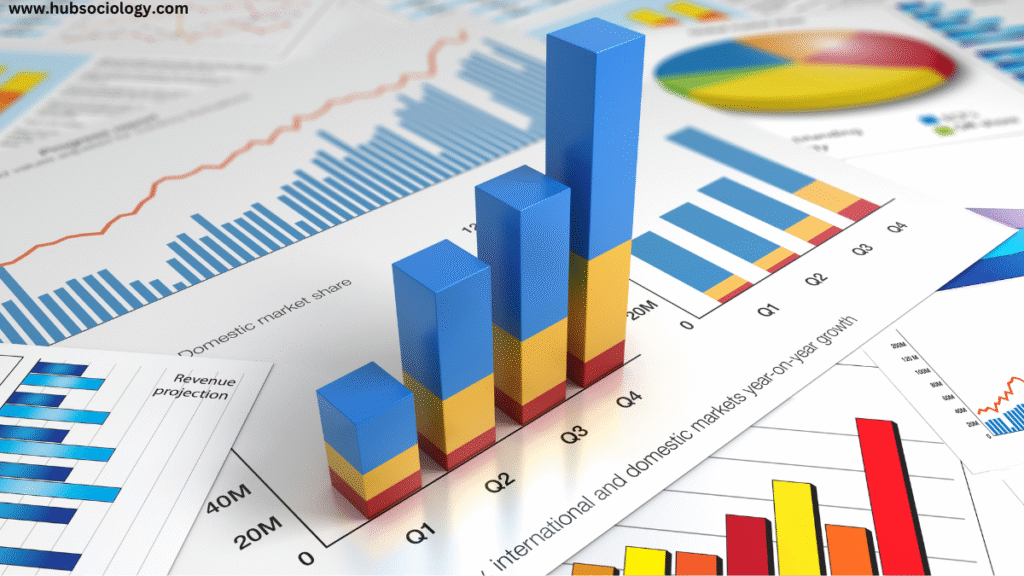Introduction
In sociology, understanding social phenomena requires analyzing large sets of data related to human behavior, economic conditions, education, crime rates, and more. To make sense of this data, sociologists rely on measures of central tendency—mean, median and mode—which help summarize and interpret complex social patterns. These statistical tools allow researchers to identify trends, compare groups, and draw meaningful conclusions about society.
This article explores the significance of mean, median and mode in sociological research, their strengths and limitations, and how they help uncover the “center” of social data. By examining real-world sociological examples, we will see how these measures shape our understanding of inequality, social norms, and policy decisions.

Table of Contents
1. Mean: The Arithmetic Average in Social Analysis
The mean is the most commonly used measure of central tendency, calculated by summing all values in a dataset and dividing by the number of observations. In sociology, the mean helps analyze:
- Income and Wealth Inequality: The mean household income provides an overview of economic conditions, but it can be skewed by extreme values (e.g., billionaires raising the average).
- Educational Attainment: The mean years of schooling in a population indicates general education levels.
- Public Opinion: Surveys measuring attitudes (e.g., average support for a policy) often use the mean.
Limitations of the Mean in Sociology
While useful, the mean can be misleading in skewed distributions. For example:
- If a neighborhood has mostly low-income families and a few ultra-wealthy individuals, the mean income will overestimate general prosperity.
- In crime statistics, a few high-crime areas can distort the mean, masking safer conditions elsewhere.
Thus, sociologists often complement the mean with the median for a more accurate picture.
2. Median: The Middle Value in Social Inequality
The median represents the middle value in an ordered dataset, making it less affected by outliers. It is particularly valuable in studying:
- Income Distribution: Median income better reflects what a “typical” person earns, especially in unequal societies.
- Housing Prices: Median home prices give a clearer sense of affordability than the mean, which can be inflated by luxury properties.
- Health Disparities: Median life expectancy avoids distortion from extreme cases (e.g., very high or very low lifespans).
Why Median Matters in Sociology
Sociologists often prefer the median when analyzing inequality. For instance:
- The U.S. Census Bureau reports median household income because it better represents the economic status of the middle class.
- Studies on urban segregation use median values to compare neighborhoods without extreme outliers skewing results.
However, the median does not account for the full distribution of data, which is where the mode can add further insight.
3. Mode: Identifying the Most Common Social Patterns
The mode is the most frequently occurring value in a dataset. In sociology, it helps identify:
- Social Norms and Behaviors: The mode can reveal the most common family structure (e.g., nuclear families vs. single-parent households).
- Crime Trends: The most frequent type of crime in a city (e.g., theft vs. violent crime) guides policy responses.
- Cultural Preferences: The most popular religion, political affiliation, or lifestyle choice in a community.
When Mode is Most Useful
- Categorical Data: Unlike mean and median, the mode works with non-numerical data (e.g., most common occupation in a town).
- Bimodal Distributions: If data has two peaks (e.g., two dominant income groups), the mode highlights polarization.
However, some datasets have no mode or multiple modes, limiting its usefulness in certain analyses.
Comparing Mean, Median and Mode in Sociological Research
| Measure | Best Used For | Strengths | Limitations |
|---|---|---|---|
| Mean | Normally distributed data (e.g., test scores, average age) | Uses all data points; good for further statistical analysis | Skewed by outliers; less reliable in unequal distributions |
| Median | Skewed data (e.g., income, wealth, housing prices) | Resistant to outliers; better for inequality studies | Ignores magnitude of extreme values |
| Mode | Categorical data (e.g., most common religion, frequent crime type) | Works with non-numeric data; identifies dominant trends | May not exist; less useful for continuous data |
Real-World Sociological Applications

Case 1: Income Inequality and Policy Decisions
- Mean Income: May suggest economic growth, but hides disparities.
- Median Income: Reveals stagnation of the middle class despite GDP growth.
- Mode Income: Shows the most common earnings bracket, highlighting working-class struggles.
Policymakers relying only on the mean might overlook poverty, while median and mode provide a clearer picture of who needs support.
Case 2: Education and Social Mobility
- Mean Years of Schooling: Can be inflated by a few highly educated individuals.
- Median Education Level: Reflects the typical citizen’s schooling.
- Mode: Indicates the most common education level (e.g., high school diploma vs. college degree).
This helps governments design targeted education policies.
Case 3: Crime Rates and Public Perception
- Mean Crime Rate: Can be distorted by a few high-crime areas.
- Median Crime Rate: Shows what most neighborhoods experience.
- Mode Crime Type: Identifies the most frequent offense (e.g., petty theft vs. violent crime).
Policing strategies can then focus on the most prevalent issues.
Conclusion: Choosing the Right Measure for Sociological Insight
Mean, median, and mode each offer unique perspectives on social data. The mean provides an overall average but can mislead in unequal societies. The median offers a more resistant measure in skewed distributions, crucial for studying inequality. The mode highlights dominant trends, especially in categorical data.

Sociologists must carefully select the appropriate measure based on their research question. Combining all three provides a comprehensive understanding of social structures, helping shape policies that address real-world inequalities and behaviors. By mastering these statistical tools, researchers can uncover the true “center” of sociological data—leading to more informed and equitable decisions.
Highly Recommended Books
- Statistics for Research: With a Guide to Spss – Amazon Link – https://amzn.to/4ksD60I
- Statistics for the Social Sciences by Sirkin R. Mark – Amazon Link – https://amzn.to/4kBe7bP
- Statistical Methods by Aggarwal – Amazon Link – https://amzn.to/4jkIfY0
Topic Related Questions on Mean, Median and Mode
5-Mark Questions on Mean, Median and Mode (Short Answer)
- Define mean, median and mode in the context of sociological research.
- Why is the median often preferred over the mean in studies on income inequality?
- Give an example where the mode is more useful than the mean or median in sociology.
- How can outliers affect the mean in sociological data? Provide an example.
- What is a bimodal distribution, and how does it apply to sociological studies?
10-Mark Questions on Mean, Median and Mode (Brief Explanation/Essay)
- Compare the strengths and weaknesses of mean, median, and mode in analyzing social data.
- Explain how the mean and median can give different perspectives on economic inequality, using real-world examples.
- Discuss the importance of measures of central tendency in policy-making, with reference to education or crime statistics.
- Why might sociologists use multiple measures of central tendency (mean, median, mode) instead of relying on just one?
- How do mean, median and mode help in understanding social norms and cultural trends? Provide examples.
15-Mark Questions on Mean, Median and Mode (Detailed Essay/Analysis)
- “The mean can be misleading in highly unequal societies.” Critically evaluate this statement with sociological examples.
- How do mean, median and mode contribute to our understanding of social stratification? Discuss with reference to class, gender, or race.
- Analyze the role of central tendency measures in shaping public perceptions of crime and economic well-being. Should policymakers rely more on median than mean? Justify your answer.
- Compare the usefulness of mean, median and mode in qualitative vs. quantitative sociological research. Can they be applied to non-numerical data?
- “Statistical measures are not neutral—they reflect and reinforce social realities.” Discuss this statement in the context of mean, median and mode in sociology.

1 thought on “Mean, Median and Mode: Finding the Center of Sociological Data”